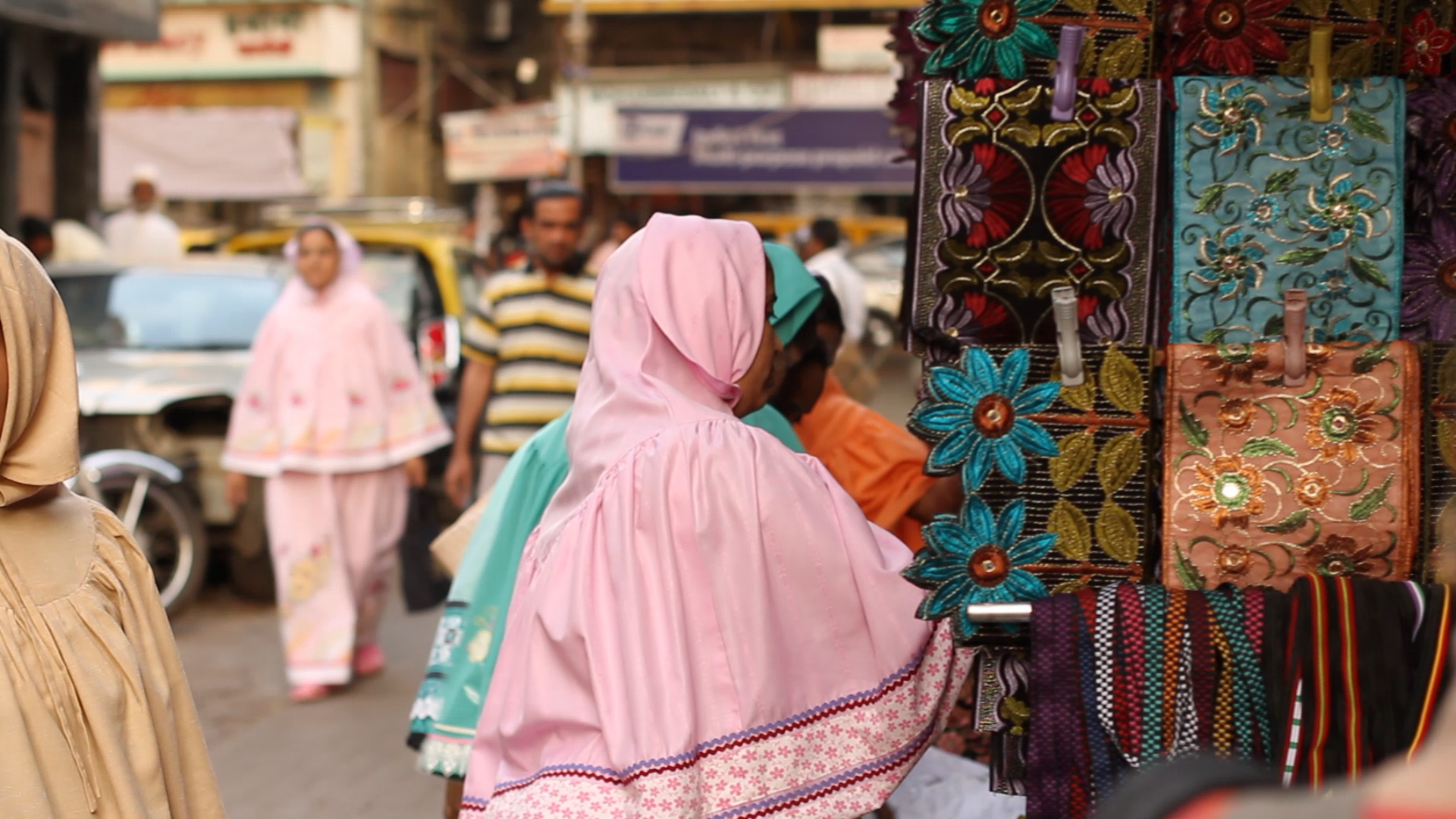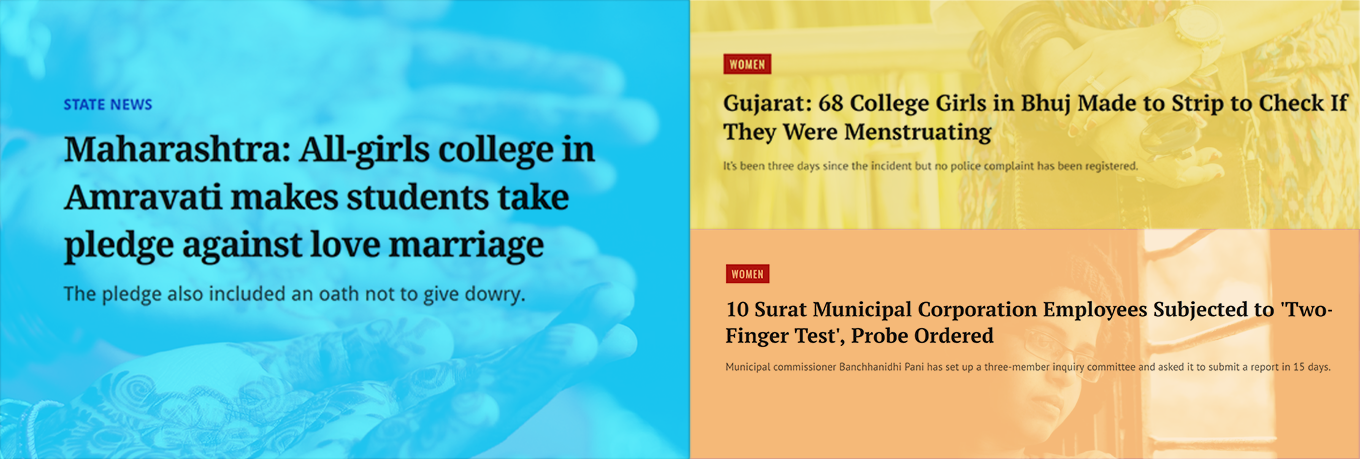By Geethika Kodukula
Country of Residence: USA
(This month, Indian news reported three disturbing incidents targeting women and girls. In the first, 68 students at a women’s college in Gujarat were forcibly strip-searched to prove they were not on their period because the college’s religious administration does not allow menstruating women to enter temples or kitchens or even touch other people. Days later, female college students in Maharashtra were forced to take an oath that they would never marry for love — instead, they would only marry husbands chosen by their parents. In a third shocking incident, 10 women applying for a government job in Gujarat were stripped and subjected to a “two-finger test” to check for pregnancy.
This essay is a cry of outrage against such acts of oppression in the name of social norms; it is an ode to women all over the world, who are forced to fight the norms of patriarchy every day in order to simply survive.)
What makes a woman?
Is it her kindness, generosity, friendship, ability to work for a living, or take care of her family? Men can do all these things just as well. But a woman can give birth, while a man cannot. We revere this ability, celebrate it and encourage girls to want it for themselves.
But not on their terms. We want to control it and shepherd it.
At an age when girls have no idea of sexuality or reproduction, we invade their bodily boundaries in the name of purity and tradition to cut their genitals. We call it khatna, sunnah, khafz, female circumcision, and practice it in more cultures around the world than we’d like to admit. We do this to our daughters in spite of the physical and psychological pain it caused us, ourselves. Girls and women who have undergone the procedure tell us that it does more harm than good.
At an age when biology decides that she becomes a woman, we likely celebrate menarche, the first period. In many cultures, we make a fuss, invite people over to bless our little girl who can now bear children and buy her new clothes, jewelry, and gifts. But she’s shocked at the blood between her legs. All her life, television commercials have shown the liquid that goes on pads and tampons as a soft blue. What is this business with blood? Is she dying? We don’t talk about that. We call the process various euphemisms. We treat these girls as impure, make them sit and sleep separately, wash their clothes and any bedding they may have touched, and essentially quarantine them every month because of this “curse” that gives us the “blessing of a child.”
We may subject her to strip searches in an institution dedicated to education, no less, to prove that she is not bleeding and can, therefore, sit, eat and mingle with her friends. What is at threat of being stripped is her dignity, which we say we value the most. We treat nearly grown adults as impure, untouchable, and stigmatize and hide all of it from the males in the house. Imagine the anxiety and resentment these young women may build toward their bodies over a completely normal biological phenomenon. We speak to females in hushed tones about how to dispose of evidence and pretend as if nothing changed.
If a woman cannot give birth due to any reason (choice being the least respected one of them), we worry, berate, label, and shame them. There is no pleasing us.
We don’t want her to look at or talk to boys for the first twenty years of her life. Then we want her to magically know how to live with a man and anticipate his wishes and whims. We want young schoolgirls to formally pledge that they will not marry for love. Let’s consider that. Even if a woman found another human being she considers compatible and wants to spend her life with him, she should reject him and marry a stranger selected by her parents based on the family he was born into, his religion/state/caste/creed, occupation, and the family’s assets and holdings. How many of these things have a real bearing on the partner he will be?
Let’s say she does marry the male her parents chose for her. What if her husband or his family wants to test her “virginity”? There are sects in India who take this very seriously. Amazon sells a product to fake your way into being a virtuous bride if you are one of the millions of women whose hymen tore while bicycling or dancing. Or if you didn’t bleed profusely the first time you had sex because–to borrow an idea this HuffPost article offers–the hymen is not a plastic wrap stretched over the Tupperware of your virginity. Imagine the disorientation this young girl may experience after being shamed and humiliated for intercourse she may not have had.
We urge newlyweds to get busy. We urge the woman to not put her career before her family and have many children. Television and movies keep showing childbirth as a briefly excruciating, but ultimately, a gratifying experience. No one says anything about postpartum complications, anxiety, or depression. Millions of people watch the Oscars but an ad about new moms’ preparedness will never reach our women since it was rejected by ABC to air.
In her homestead our woman lives as happy as one can be in her place in society. But according to Krushnaswarup Dasji, she cannot cook for her family for five days a month, (longer if she has reproductive issues). Her husband’s family never got around to teaching him how to cook. This is a dilemma, indeed. Her husband and sometimes her children resent her for making them eat take-out.
As she enters menopause, she is viewed as less useful than she was, no longer able to bear children.
Having lived a life carrying back-breaking gender norms, she dies to finally be at peace from societies’ expectations.
Our loud proclamations that we celebrate women and womanhood while silencing everything that makes one a woman is sending mixed signals to young girls. We celebrate the arrival of periods, then treat it like a disease and put young girls at risk by asking them to stay outside a village in a hut while on their periods. We say God (any interpretation of Him/Her), who created all of us, deigned that women are impure if their bodies are behaving the way human bodies should. The all-knowing, omnipotent God who many of us talk to on a daily basis, decided that cisgender females were going to be powerful enough to create and carry life themselves, but the body’s reaction to not doing that every year of their lives is to be treated as impure and icky. Virginity is an outdated, if not meaningless, concept. We should look at what we are subjecting our living mothers, sisters, and daughters to in the name of a God who never even said all menstruating women should be shunned.
“Culture does not make people. People make culture. If it is true that the full humanity of women is not our culture, then we can and must make it our culture.” ― Chimamanda Ngozi Adichie, We Should All Be Feminists
Norms and rules are necessary for any society or group of people. Cultural and social norms are dynamic, shaped by the people who follow them or stop following them. If things didn’t change, many of us would still be wearing gowns and suits and curtsying or bowing every time we met an acquaintance. We Indians would be doing what our fathers and grandfathers did, potters trapped in doctors’ bodies or the other way around. We have to normalize menstruating so that we can then address period poverty — many young women are unable to access the supplies they need to manage their period. They may resort to means that can give them infections and reproductive diseases. It’s high time that some gender norms change. Thank goodness they are changing, slowly but surely. Women should not be treated as less than men and as mere vehicles to carry generations forward. They possess the same consciousness, conscience, and essence in a different body.







